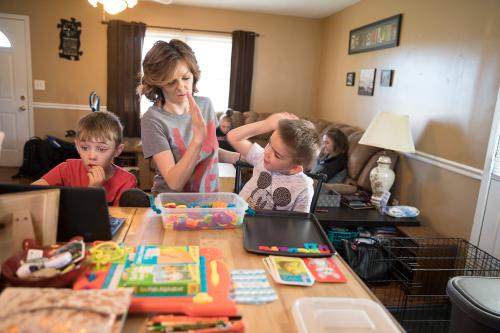Automation and artificial intelligence are transforming work at a dizzying pace. Rapid technological advances will require a forward-looking workforce that is ready to adapt. While much of the policy discussion has focused on the role of college, not all students attend college, and not all who do are ready for a rigorous technology-driven education. To prepare students for an increasingly automated future, we need to modernize K-12 education. This need is particularly obvious as children return to school this year; because of COVID-19, some students are learning online, others in person, and others in pods made up of children whose parents can afford to hire personal teachers.
Students need an educational overhaul to help them build a strong foundation for the economy of the future. To investigate what this reform may look like, we asked four experts how they would redesign K-12 education. They eschew incremental change, and instead reimagine what a successful educational system of the future might look like. They discuss their bold ideas for renovating education in this video series.
5 ideas to improve universal education: Emiliana Vegas
Emiliana Vegas, EdD, outlines five key ways to improve universal education:
1. Improve differentiated learning. Learning doesn’t only take place in schools— it is often achieved through different approaches and pathways. Students should be empowered to learn at their own pace.
2. Improve technology by:
- Scaling quality instruction
- Facilitating differentiated instruction
- Expanding opportunities for practice
- Increasing student engagement through games and videos
3. Recognize the role of schools in non-academic areas, including socio-emotional development and child care. Teachers are doing a lot for the next generation. We should change the education system—both financially and structurally—to account for the wide scope of issues and subjects they address.
4. Focus on teaching students transferable skills, including creativity, problem solving, and analytical thinking.
5. Provide more attention and resources to those who have the least at home, as laid bare by COVID-19. Limited financial, technological, and personnel resources should be allocated to the students who need them most.
Taken together, these five ideas will help equip students for a changing work environment that increasingly relies on technology.
Marry cultural competence with technical skills to improve equity: A. Nicki Washington
Nicki Washington, PhD, explains that technological development often excludes minority groups. It is imperative, in her view, that schools teach equity and inclusion alongside technical skills. Educators cannot assume that students already understand these issues, and even though they can be hard to discuss, they are necessary to improve students’ current education, their future work environments, and their ability to complement the technology that they will use in their careers.
Furthermore, even though equity and diversity skills are not often seen as a key component of the technical toolkit, a lack of competence in this area can lead to technological discrimination: that is, the creation of software without all users in mind. These problems can lead to, at best, a poor customer experience, or at worst, a loss of income or even loss of life.
Teaching inclusion and diversity affects students beyond the classroom, impacting their future careers and the evolution of workplace norms and technology.
Schools need to be comfortable creating curricula that discuss these issues and challenge students to grow not just technically, but also ethically. Teaching inclusion and diversity affects students beyond the classroom, impacting their future careers and the evolution of workplace norms and technology.
Foster community involvement and personalized learning plans: Paul Reville
Paul Reville, EdM, outlines two major ways to reimagine K–12 education:
1. Create local children’s cabinets
Schools don’t have the resources to serve all of children’s out-of-school needs, nor should they be expected to. But children’s performance in class is impacted by their experience at home and in their communities. To create an equitable “cradle to career pipeline” that prepares students for the economy of the future, communities should play an active role in improving the policies of youth-serving organizations and institutions.
A mayor or city council can formally establish a children’s cabinet to do just that: bring together community members, government officials, business leaders, parent organizations, and student organizations to develop strategies to better student outcomes.
2. Adopt a system of personalized navigation and success planning
As it stands, the education system serves a diverse set of students with a one-size-fits-all approach. Business and medicine are personalized, but education rarely is. We need to “meet students where they are” and provide them with the resources that they need in and out of school. Doing so will require a liaison that works closely with a student and their family to help them develop a personalized success plan that emphasizes career skills, too. Personalized learning isn’t entirely new—individualized education plans are already used for students with special needs and students that fail to meet certain benchmarks. It’s time to expand the approach to the broader student population.
Increasing community investment in students’ education and expanding personalized learning would reshape the education environment, and prepare students for the workplace of the future.
Leverage the challenges of COVID-19 for change: Jimmy Sarakatsannis
It’s no surprise that COVID-19 has drastically changed schools, but Jimmy Sarakatsannis, former middle school science teacher and current partner at McKinsey, explains how some of these challenges have also created opportunity for change. For example, although school closures are exacerbating existing inequalities, they are also creating awareness that may challenge existing education models. Technology penetration has also increased, and with it, the possibility of preparing students for a technology-driven world.
So, what can educators and policy makers do?
- Focus on creating equitable funding models and reducing segregation
- Recommit to quality evidence-based instruction
- Identify and support great teachers
- Adjust based on context
In order to make some of these ideas a reality, we need to improve how we train and allocate teachers. One possibility is to link teacher training to schools in the same fashion that medical schools are linked to hospitals. We should also rethink teacher career progression by creating a wider gradient of positions and placing more emphasis on teacher skill development. Schools can also use technology to connect experienced teachers with more students. Instead of just distributing devices, schools can use them thoughtfully and personally. Schools must also support students holistically by focusing on mental and emotional health in addition to their academic needs. While these ideas span from teachers’ work structure to ensuring students’ emotional support, they all center on improving the student experience and improving their outcomes when they enter the workforce.
Conclusion
Technology will undoubtedly transform work. Our educational system will have to evolve to prepare the next generation of workers for these changes. Students need skills that translate to technological adaptability: creativity, critical thinking, and technological competence.
Teaching those skills will require a substantial investment in personalized learning plans, investment in talented teachers, and equitable access to education. Schools also ought to recognize the non-academic role they play, and communities ought to ensure that children have the capacity to succeed beyond school doors.
COVID-19 has unmistakably disrupted schools, but—as Jimmy Sarakatsannis points out—the chaos may provide an opportunity for educators and policy makers to revamp curricula to better serve students.
The Brookings Institution is committed to quality, independence, and impact.
We are supported by a diverse array of funders. In line with our values and policies, each Brookings publication represents the sole views of its author(s).









Commentary
Big ideas to redesign K-12 for the automation age
October 12, 2020